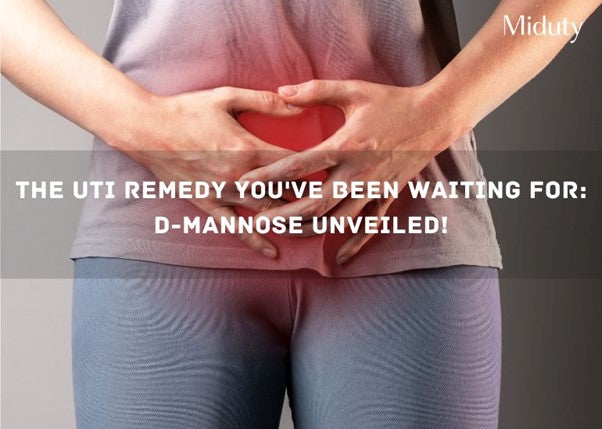
The UTI Remedy You've Been Waiting For: D-Mannose Unveiled!
Imagine yourself going about your day, crossing things off your to-do list with happiness, then all of a sudden, a familiar uneasiness sets in. The burning sensation, the urgency, the relentless trips to the bathroom – yes, I am talking about the all-too-common struggle of urinary tract infections (UTIs), especially experienced by women. If you're nodding your head in recognition, you're not alone.
Every woman who has experienced a UTI is aware of the chaos it causes in your life. It is similar to an unwanted visitor who shows up uninvited and overstays their welcome.
As you struggle with the unpleasant symptoms, even the smallest things become difficult. Fear not, though, as help may be closer than you think. It comes in the form of a natural treatment that has recently gained popularity: D-Mannose.
Permit me to relate a personal story: a few months ago, someone I knew got caught in the grips of yet another UTI. She was feeling so frustrated that word doesn't even begin to describe it. But when she asked for my opinion this time, I gave a different suggestion: D-Mannose.
She made an immediate but sceptical decision to try it. She was surprised to notice the difference after a day. She could finally think about something other than her timetable for using the bathroom after the burning sensation and sense of urgency disappeared.
If you're tired of relying on antibiotics or if you're simply searching for a more natural way to tackle UTIs, you're in for a treat. In this blog post, we're diving into the UTI remedy you've been eagerly waiting for – D-Mannose. We'll explore what D-Mannose is, how it works its magic, and what science has to say about its effectiveness.
Understanding UTIs
Everyone can have urinary tract infections (UTIs), but women are more likely to get them than males do. When germs, most frequently Escherichia coli (E. coli), enter the urinary tract and grow there, an illness known as a UTI results.
The kidneys, bladder, ureters, and urethra are just a few of the components that make up the urinary system. Bacteria that move up the urethra and enter the bladder can result in cystitis, a bladder infection. The illness grows more serious and is known as pyelonephritis if the infection gets to the kidneys.
Causes of UTIs:
The bacterium E. coli, which often lives in the digestive tract, is what causes the majority of UTIs. E. coli can attach to the bladder or urethral walls and cause illness, though, if it passes through the urethra and enters the urinary tract. Due to their shorter urethras, which make it easier for bacteria to enter the bladder, women are more prone to UTIs.
The risk of UTIs can also be raised by certain forms of contraception, pregnancy, and sexual activity.

Symptoms of UTIs:
The severity of a UTI's symptoms might vary, but typically they consist of:
- Frequent urination: Even if they only pass a tiny volume of urine, people with UTIs typically feel the need to urinate more frequently than usual.
- Burning: A common symptom is pain or a burning feeling when urinating. The irritation of the irritated urinary system is what's causing this discomfort.
- Urgency: A sudden, urgent urge to urinate that might be challenging to control.
- Pain or discomfort: Lower abdominal pressure or pain is frequently felt, accompanied with a general discomfort.
- Cloudy or bloody urine: Urine that appears cloudy or bloody may be deeper in color or possibly have traces of blood in it.
- Urine with an unpleasant odor: UTIs can occasionally have an unpleasant odor.
Traditional UTI Treatments - Why Antibiotics Are Not Helpful?
Antibiotics, which are prescription medications created to target and get rid of bacterial infections, are frequently used to treat urinary tract infections (UTIs). Antibiotics have traditionally been the first line of protection against UTIs, but they have some disadvantages and risks that have led to the research into alternatives, such as D-Mannose.
The usual treatment recommended by medical specialists to treat UTIs is an antibiotic. These drugs function by killing or avoiding the development of the infection-causing microorganisms.
Antibiotics successfully get rid of germs that cause UTIs, but they have a few negative aspects:
Antibiotic Resistance: The overuse and improper use of antibiotics have caused the emergence of bacteria that are resistant to them. This implies that some bacteria have changed over time to resist the effects of antibiotics, making infections more challenging to treat going forward. This suggests the need for alternate methods of treatment and is a major concern in the medical community.
Affecting Gut Bacteria: Antibiotics don't distinguish between the good bacteria in the gut and the pathogenic bacteria causing the infection. Due to imbalances in the gut microbiome, this may result in gastrointestinal difficulties, reduced immunity, and other health issues.
Side Effects: Antibiotics may have a variety of unfavorable side effects, such as nausea, vomiting, diarrhea, and allergic reactions. Long-term usage of antibiotics may make these side effects more likely.
Long-Term Use and Recurrence: Antibiotics are frequently used to treat acute UTIs in the short term. Due to the possibility of antibiotic resistance and recurrent infections, they might not be suitable for long-term protection.
Additionally, antibiotics do not deal with the bacteria that attach to the urinary tract walls, which is the primary cause of UTIs. D-Mannose and other alternatives have a role in this. D-Mannose is a viable therapy and preventative measure without the hazards connected with antibiotic overuse since it provides a method to stop bacteria from attaching to the urinary system.
Introducing D-Mannose: A Natural Alternative and Science Behind It!
Urinary tract infections (UTIs) are becoming more popular, and one natural option is D-mannose. A simple sugar that occurs naturally and is related to glucose is called D-mannose. It can be found in a variety of fruits, such as peaches, cranberries, and apples.
Due to its potential to prevent and treat UTIs without the negative side effects associated with antibiotics, this sugar has attracted attention. D-Mannose is typically sold as a supplement, a powder, or a pill.
The power of D-Mannose to stop E. coli bacteria from attaching to the walls of the urinary system is the key to its efficiency. D-Mannose enters the bloodstream after consumption, passes through the digestive tract, and then enters the urine tract. Its mode of operation is as follows:
Attaches to Bacteria: E. coli bacteria can attach to the bladder and urethral walls thanks to a small structure like a hair called a pili. These attachments make it possible for the bacteria to grow and spread illness.
Competitive Binding: D-Mannose molecules have a structure that is comparable to those on the surface of the walls of the urinary tract. When there is D-Mannose in the urine, bacteria are drawn to it and attach to the sugar molecules rather than the walls of the urinary system.
Flushing Out Bacteria: Bacteria are flushed out because they can no longer stick to the walls of the urinary system because they are now attached to D-Mannose. Instead of producing an illness, they are instead flushed out of the body during urination.
In conclusion, by utilizing its capacity to prevent the attachment of bacteria in the urinary system, D-Mannose presents a viable strategy for UTI prevention and therapy.
Incorporating D-Mannose in Your LifeStyle
Urinary tract infections (UTIs) can be actively avoided by including D-Mannose into your everyday practice. While D-Mannose offers a safe and efficient method, combining it with specific lifestyle habits can increase its advantages and improve urinary tract health in general.
The secret to its effectiveness is consistency. Consistently incorporate D-Mannose into your regimen to keep it in your urinary system.
Although D-mannose is present in berries and cranberries, it may not be present in sufficient quantities to have the required therapeutic effects.
Supplements are frequently advised in order to obtain a more concentrated and focused dose of D-mannose. When utilizing D-mannose to treat particular health issues, these supplements offer a higher and more regular dosage, which can be crucial.
Miduty UTI Releif is one such supplement that can help you ease the discomfort brought on by UTIs. The D-mannose utilized in this supplement is in a Liposomal form, making it 16X more potent than the regular type of D-mannose. It prevents the bad bacteria from sticking to the walls of the urinary system.
Final Words
In conclusion, those who have struggled with the enduring discomfort of UTIs have some hope thanks to the discovery of D-Mannose as a viable treatment. Many people, especially women, have experienced the familiar burning sensation, urgency, and disturbed habits brought on by these illnesses.
The struggle with UTIs can have a negative impact on one's health, but D-Mannose offers hope. You may be able to say goodbye to the discomfort that UTIs cause by accepting this natural treatment and implementing it into a proactive lifestyle. Maintaining the health of your urinary tract requires consistency, and Miduty's UTI Relief may be your ally in this regard. Keep in mind that every action you take to improve your health is worthwhile.








